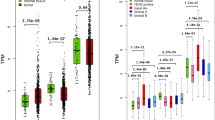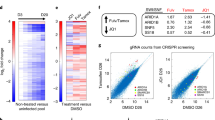Abstract
Mutations in the BRCA1-interacting DEAH helicase Brip1 confer an increased risk of breast cancer. In the present study we aimed to unravel the transcriptional control of Brip1 and to determine its expression levels in a set of 101 primary invasive breast carcinomas. Transcription of Brip1 was found to be cell growth-related and controlled by the E2F/retinoblastoma (Rb) pathway through a conserved E2F-responsive site. Repression of Brip1 expression by the cell growth-inhibiting compound 1α,25-dihydroxyvitamin D3 depended on this same E2F-responsive site. In spite of its role as a tumor suppressor, both quantitative reverse transcriptase-PCR analyses and immunohistochemical stainings showed significantly elevated Brip1 expression levels in grade 3 tumors as compared to grade 1 or 2 carcinomas. Furthermore, increased Brip1 transcript levels were found in tumors with an estrogen receptor-negative, progesterone receptor-negative or HER-2-positive status. In conclusion, these data show that Brip1 is a genuine target gene for the E2F/Rb pathway and that elevated expression levels of Brip1 are detected in primary invasive breast carcinomas with unfavorable characteristics.
This is a preview of subscription content, access via your institution
Access options
Subscribe to this journal
Receive 50 print issues and online access
$259.00 per year
only $5.18 per issue
Buy this article
- Purchase on Springer Link
- Instant access to full article PDF
Prices may be subject to local taxes which are calculated during checkout




Similar content being viewed by others
References
Bracken AP, Ciro M, Cocito A, Helin K . (2004). E2F target genes: unraveling the biology. Trends Biochem Sci 29: 409–417.
Bridge WL, Vandenberg CJ, Franklin RJ, Hiom K . (2005). The BRIP1 helicase functions independently of BRCA1 in the Fanconi anemia pathway for DNA crosslink repair. Nat Genet 37: 953–957.
Cantor S, Drapkin R, Zhang F, Lin Y, Han J, Pamidi S et al. (2004). The BRCA1-associated protein BACH1 is a DNA helicase targeted by clinically relevant inactivating mutations. Proc Natl Acad Sci USA 101: 2357–2362.
Cantor SB, Bell DW, Ganesan S, Kass EM, Drapkin R, Grossman S et al. (2001). BACH1, a novel helicase-like protein, interacts directly with BRCA1 and contributes to its DNA repair function. Cell 105: 149–160.
Chin K, DeVries S, Fridlyand J, Spellman PT, Roydasgupta R, Kuo WL et al. (2006). Genomic and transcriptional aberrations linked to breast cancer pathophysiologies. Cancer Cell 10: 529–541.
D'Andrea AD, Grompe M . (2003). The Fanconi anaemia/BRCA pathway. Nat Rev Cancer 3: 23–34.
Eelen G, Gysemans C, Verlinden L, Vanoirbeek E, De Clercq P, Van Haver D et al. (2007). Mechanism and potential of the growth-inhibitory actions of vitamin D and Analogs. Curr Med Chem 14: 1893–1910.
Eelen G, Verlinden L, Van Camp M, Mathieu C, Carmeliet G, Bouillon R et al. (2004a). Microarray analysis of 1α, 25-dihydroxyvitamin D3-treated MC3T3-E1 cells. J Steroid Biochem Mol Biol 89-90: 405–407.
Eelen G, Verlinden L, Van Camp M, van Hummelen P, Marchal K, de Moor B et al. (2004b). The effects of 1alpha, 25-dihydroxyvitamin D3 on the expression of DNA replication genes. J Bone Miner Res 19: 133–146.
Fridlyand J, Snijders AM, Ylstra B, Li H, Olshen A, Segraves R et al. (2006). Breast tumor copy number aberration phenotypes and genomic instability. BMC Cancer 6: 96.
Giangrande PH, Zhu W, Schlisio S, Sun X, Mori S, Gaubatz S et al. (2004). A role for E2F6 in distinguishing G1/S- and G2/M-specific transcription. Genes Dev 18: 2941–2951.
Ishida R, Buchwald M . (1982). Susceptibility of Fanconi's anemia lymphoblasts to DNA-cross-linking and alkylating agents. Cancer Res 42: 4000–4006.
Levitus M, Waisfisz Q, Godthelp BC, de Vries Y, Hussain S, Wiegant WW et al. (2005). The DNA helicase BRIP1 is defective in Fanconi anemia complementation group J. Nat Genet 37: 934–935.
Levran O, Attwooll C, Henry RT, Milton KL, Neveling K, Rio P et al. (2005). The BRCA1-interacting helicase BRIP1 is deficient in Fanconi anemia. Nat Genet 37: 931–933.
Litman R, Peng M, Jin Z, Zhang F, Zhang J, Powell S et al. (2005). BACH1 is critical for homologous recombination and appears to be the Fanconi anemia gene product FANCJ. Cancer Cell 8: 255–265.
Paris PL, Andaya A, Fridlyand J, Jain AN, Weinberg V, Kowbel D et al. (2004). Whole genome scanning identifies genotypes associated with recurrence and metastasis in prostate tumors. Hum Mol Genet 13: 1303–1313.
Perou CM, Sorlie T, Eisen MB, van de RM, Jeffrey SS, Rees CA et al. (2000). Molecular portraits of human breast tumours. Nature 406: 747–752.
Pharoah PD, Antoniou A, Bobrow M, Zimmern RL, Easton DF, Ponder BA . (2002). Polygenic susceptibility to breast cancer and implications for prevention. Nat Genet 31: 33–36.
Poll EH, Arwert F, Joenje H, Eriksson AW . (1982). Cytogenetic toxicity of antitumor platinum compounds in Fanconi's anemia. Hum Genet 61: 228–230.
Raemaekers T, Ribbeck K, Beaudouin J, Annaert W, Van Camp M, Stockmans I et al. (2003). NuSAP, a novel microtubule-associated protein involved in mitotic spindle organization. J Cell Biol 162: 1017–1029.
Saiz AD, Olvera M, Rezk S, Florentine BA, McCourty A, Brynes RK . (2002). Immunohistochemical expression of cyclin D1, E2F-1, and Ki-67 in benign and malignant thyroid lesions. J Pathol 198: 157–162.
Seal S, Thompson D, Renwick A, Elliott A, Kelly P, Barfoot R et al. (2006). Truncating mutations in the Fanconi anemia J gene BRIP1 are low-penetrance breast cancer susceptibility alleles. Nat Genet 38: 1239–1241.
Sinclair CS, Rowley M, Naderi A, Couch FJ . (2003). The 17q23 amplicon and breast cancer. Breast Cancer Res Treat 78: 313–322.
Sorlie T . (2004). Molecular portraits of breast cancer: tumour subtypes as distinct disease entities. Eur J Cancer 40: 2667–2675.
Verlinden L, Eelen G, Beullens I, Van Camp M, Van Hummelen P, Engelen K et al. (2005). Characterization of the condensin component Cnap1 and protein kinase Melk as novel E2F target genes down-regulated by 1, 25-dihydroxyvitamin D3 . J Biol Chem 280: 37319–37330.
Verlinden L, Vanden Bempt I, Eelen G, Drijkoningen M, Verlinden I, Marchal K et al. (2007). The E2F-regulated gene Chk1 is highly expressed in triple-negative estrogen receptor/progesterone receptor/HER-2 breast carcinomas. Cancer Res 67: 6574–6581.
Whitfield ML, George LK, Grant GD, Perou CM . (2006). Common markers of proliferation. Nat Rev Cancer 6: 99–106.
Yan Z, DeGregori J, Shohet R, Leone G, Stillman B, Nevins JR et al. (1998). Cdc6 is regulated by E2F and is essential for DNA replication in mammalian cells. Proc Natl Acad Sci USA 95: 3603–3608.
Yang L, Han Y, Saurez SF, Minden MD . (2007). A tumor suppressor and oncogene: the WT1 story. Leukemia 21: 868–876.
Yu X, Chini CC, He M, Mer G, Chen J . (2003). The BRCT domain is a phospho-protein binding domain. Science 302: 639–642.
Zacharatos P, Kotsinas A, Evangelou K, Karakaidos P, Vassiliou LV, Rezaei N et al. (2004). Distinct expression patterns of the transcription factor E2F-1 in relation to tumour growth parameters in common human carcinomas. J Pathol 203: 744–753.
Zhang SY, Liu SC, Al Saleem LF, Holloran D, Babb J, Guo X et al. (2000). E2F-1: a proliferative marker of breast neoplasia. Cancer Epidemiol Biomarkers Prev 9: 395–401.
Acknowledgements
We thank Ine Beullens, Mark Van Camp, Suzanne Marcelis, Biauw Keng Tan and Laura Kozak for excellent technical assistance and Dr JR Nevins and Dr J Magae for providing materials. This work is supported by grants from the Fund for Scientific Research (FWO-G.0508.05 and FWO-G0553.06) and the KU Leuven Research Council (EF/05/007 SymBioSys). GE is a postdoctoral fellow for the Fund for Scientific Research (FWO). The authors have no conflict of interest.
Author information
Authors and Affiliations
Corresponding author
Rights and permissions
About this article
Cite this article
Eelen, G., Vanden Bempt, I., Verlinden, L. et al. Expression of the BRCA1-interacting protein Brip1/BACH1/FANCJ is driven by E2F and correlates with human breast cancer malignancy. Oncogene 27, 4233–4241 (2008). https://doi.org/10.1038/onc.2008.51
Received:
Revised:
Accepted:
Published:
Issue Date:
DOI: https://doi.org/10.1038/onc.2008.51
Keywords
This article is cited by
-
Homologous repair deficiency score for identifying breast cancers with defective DNA damage response
Scientific Reports (2020)
-
Comprehensive molecular biomarker identification in breast cancer brain metastases
Journal of Translational Medicine (2017)
-
SWIM: a computational tool to unveiling crucial nodes in complex biological networks
Scientific Reports (2017)
-
Targeted Therapies for Adrenocortical Carcinoma: IGF and Beyond
Hormones and Cancer (2011)
-
Targeting the FANCJ–BRCA1 interaction promotes a switch from recombination to polη-dependent bypass
Oncogene (2010)



